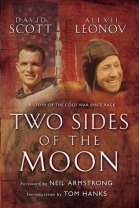 It must have sounded like a neat idea when they pitched it to the publisher: a NASA astronaut and a Soviet cosmonaut, both of whom were involved in the Space Race, each telling their own side of the story. Except there isn’t that much linking David Scott and Alexei Leonov. They met several times, and even became friends. But Scott was in the third group of NASA astronauts, flew once in Gemini and twice in Apollo; but Leonov was in the first group of cosmonauts, a close personal friend of Yuri Gagarin, and flew once in Voskhod and once in Soyuz/ASTP.
It must have sounded like a neat idea when they pitched it to the publisher: a NASA astronaut and a Soviet cosmonaut, both of whom were involved in the Space Race, each telling their own side of the story. Except there isn’t that much linking David Scott and Alexei Leonov. They met several times, and even became friends. But Scott was in the third group of NASA astronauts, flew once in Gemini and twice in Apollo; but Leonov was in the first group of cosmonauts, a close personal friend of Yuri Gagarin, and flew once in Voskhod and once in Soyuz/ASTP.
True, Scott made it to the Moon, and Leonov was made commander of the USSR’s failed attempt to put a man on the Moon. But Leonov also commanded the Soviet half of the Apollo-Soyuz Test Project. The US side was commanded by Thomas Stafford (see here). Scott was involved only as a liaison with the Russians – in fact, that’s how he came to know Leonov. Even then, the sections of Two Sides of the Moon recounting that first visit from either viewpoint read like two reports on two entirely different trips.
If there’s a fault to Two Sides of the Moon, it’s that: the book reads like two autobiographies published together without any real connection between the two. Which is not to say that those individual accounts are not interesting. Scott’s is perhaps lighter on technical detail than the autobiographies of some of his peers, and Leonov’s does display a tendency to repeatedly stress his importance within the Soviet cosmonaut corps. Both quickly cover the lives of their subjects prior to joining their respective space programmes. Only Leonov seems to remark on the differences between how the programmes were run, and several times remarks on his surprise at learning that the NASA astronauts were not as rigorously managed in terms of diet and exercise as the cosmonauts were. Leonov’s account also makes it clear that the Soviet space programme was much cruder than that of the US – indeed, facilities at Baikonur were initially extremely basic, and those involved spent as little time there as they possibly could.
Scott recounts the details of his Gemini 8 mission, the one in which he and Neil Armstrong nearly came a cropper due to a faulty RCS vernier. He focuses more, understandably, on Apollo 15, the mission he commanded which landed on Mare Imbrium and explored the region around it, including Rima Hadley and the foothills of the Apennines. These are among the most interesting sections of the book.
By comparison, Leonov appeared to be involved in more failed missions than successful ones. In fact, he flew only twice – though one of his flights, admittedly, did make him the first person to walk in space. He was set to command Soyuz 11, but was pulled off after one his crew was diagnosed with suspected tuberculosis. The backup crew of Vladislav Volkov, Georgi Dobrovolski and Viktor Patsayev died on ther return from Salyut 1 when a release valve opened prematurely and evacuated the descent module’s atmosphere. Leonov was then put in command of the Zond programme to put a cosmonaut on the Moon, and blames the lack of courage of Vasiliy Mishin, Sergei Korolev‘s successor as head of the Soviet space programme, for its failure. Mishin repeatedlt insisted on unmanned tests, when a manned test could have put a Russian in lunar orbit before Apollo 8. And perhaps even put Leonov on the lunar surface before Apollo 11.
It’s clear that Two Sides of the Moon was written as the reminiscences of Scott and Leonov – their central position in their respective narratives indicates as much. But where their memories might have failed or misled them, you would have thought the ghost writer (Christine Toomey) would have fact-checked. And yet errors have slipped in. Perhaps the most egregious is Scott’s claim that Neil Armstrong’s motto was, “If you can’t be good, be colourful”. He even tells an anecdote about it. Except that motto was Pete Conrad‘s, as even a cursory search on the Internet will reveal.
If Scott and Leonov are not the obvious choices to have their stories put together, at least both tell interesting tales. The fact that those stories don’t seem to fit together particularly well seems almost incidental. Two Sides of the Moon is certainly a readable book, and a faster read than many other books on the Space Race. There are better astronaut autobiographies than Scott’s – Michael Collin’s Carrying the Fire (see here) and Thomas Stafford’s We Have Capture (see here) are two examples – but Two Sides of the Moon is also by and about Alexei Leonov, and his story lifts Two Sides of the Moon above many other such books on the Space Race.
Two Sides of the Moon, David Scott and Alexei Leonov (2004, Simon & Schuster, ISBN 0-7342-3162-7, 390pp + acknowledgements, glossary, bibliography and index)